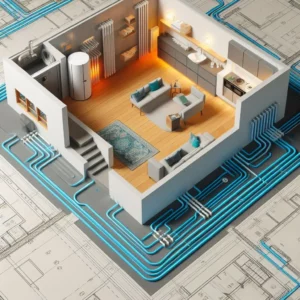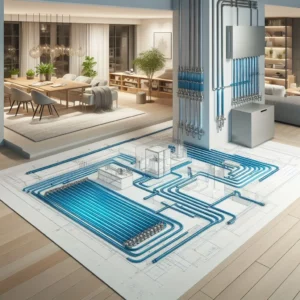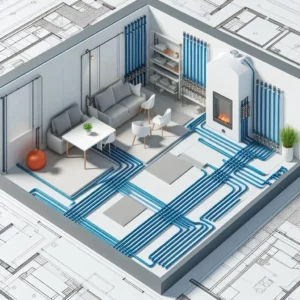Introduction to Hydronic Underfloor Heating
Hydronic underfloor heating is a modern and efficient way of heating residential and commercial spaces. Unlike traditional heating systems that rely on forced air or radiators, Hydronic underfloor heating uses water or a mixture of water and antifreeze circulating through pipes installed beneath the floor. This innovative heating method offers several advantages over conventional heating systems, making it increasingly popular among homeowners and builders and even in our company: SVR Trace!
One of the key benefits of Hydronic underfloor heating is its ability to provide consistent and comfortable warmth throughout the space. Since the heat is emitted from the floor surface, it creates a gentle and even distribution of warmth, eliminating cold spots commonly found with other heating methods. This uniform heating not only enhances comfort but also improves energy efficiency by reducing heat loss. Check our shop for the best hydronic heating systems and order now!
Another advantage of Hydronic underfloor heating is its compatibility with various types of flooring materials, including tiles, hardwood, laminate, and even carpet. This versatility allows homeowners to enjoy the benefits of radiant heating without compromising on their preferred flooring aesthetics. Additionally, the installation of Hydronic underfloor heating can increase property value and appeal to potential buyers looking for modern and energy-efficient heating solutions.
Hydronic underfloor heating systems are also known for their silent operation, as they do not rely on noisy fans or blowers commonly associated with forced-air systems. This quiet heating method creates a more peaceful and comfortable indoor environment, free from the noise disruptions often experienced with traditional heating systems.
Furthermore, Hydronic underfloor heating can be easily integrated with renewable energy sources such as solar thermal panels or geothermal heat pumps, further reducing energy costs and environmental impact. This makes it a sustainable heating option for eco-conscious homeowners seeking to reduce their carbon footprint.
In conclusion, the introduction of Hydronic underfloor heating represents a significant advancement in heating technology, offering consistent warmth, compatibility with various flooring materials, quiet operation, and the potential for energy savings and sustainability.
Visit our blog page for the newest content about industrial products and household products in the field of the hydronic heating!
- What are the Types of Hydronic Underfloor Heating Systems?
- What are the Advantages and Disadvantages of Hydronic Underfloor Heating?
- What is the Installation and Commissioning Process of Hydronic Underfloor Heating Systems?
- How to Select Suitable Materials and Equipment for Hydronic Systems?
- What are some Maintenance and Repair Tips for Hydronic Underfloor Heating Systems?
- What are the Applications of Hydronic Underfloor Heating in Residential, Commercial, and Industrial Settings?
- What are Energy Efficiency and Environmental Impact of Hydronic Underfloor Heating?
- What are Optimization Strategies for Hydronic Underfloor Heating Systems?
These are the questions that will be answered in this article. So lets continue!
Table of contents
- Introduction to Hydronic Underfloor Heating
- Types of Hydronic Underfloor Heating Systems
- Advantages and Disadvantages of Hydronic Underfloor Heating
- Installation and Commissioning Process of Hydronic Underfloor Heating Systems
- Selection of Suitable Materials and Equipment for Hydronic Systems
- Maintenance and Repair Tips for Hydronic Underfloor Heating Systems
- Applications of Hydronic Underfloor Heating in Residential, Commercial, and Industrial Settings
- Energy Efficiency and Environmental Impact of Hydronic Underfloor Heating
- Optimization Strategies for Hydronic Underfloor Heating System
- FAQs
- Conclusion
Types of Hydronic Underfloor Heating Systems

Hydronic underfloor heating systems come in various types, each offering unique features and benefits suited to different building requirements and preferences. Understanding the different types can help homeowners and builders choose the most suitable option for their heating needs. Here are some common types of Hydronic underfloor heating systems:
1. Hydronic Radiant Floor Heating:
This is the most traditional type of Hydronic underfloor heating, where hot water or a mixture of water and antifreeze flows through pipes installed within the floor structure. The heat radiates upwards from the floor surface, providing even warmth throughout the room.
2. Electric Hydronic Underfloor Heating:
Unlike the traditional water-based systems, electric Hydronic underfloor heating uses heating cables or mats installed beneath the flooring. When electricity passes through these elements, they generate heat, which warms the floor and radiates upwards into the room. Electric systems are often preferred for their quick response time and individual room control. There are also oil and gas industry and systems.
3. Hybrid Hydronic Underfloor Heating:
This type combines the benefits of both water-based and electric systems. A hybrid system may use a combination of water pipes and electric heating elements strategically placed in different areas of the floor. This hybrid approach allows for efficient heating while offering flexibility and control.
4. In-slab Hydronic Underfloor Heating:
In this system, the heating pipes or cables are embedded within the concrete slab of the floor. As the concrete heats up, it radiates warmth into the living space. In-slab heating is commonly used in new construction or major renovations where the floor structure can accommodate the installation within the concrete.
5. In-screed Hydronic Underfloor Heating:
Similar to in-slab heating, in-screed systems involve embedding the heating elements within a screed layer on top of the subfloor. This method allows for faster response times compared to in-slab systems and is suitable for retrofitting existing floors.
6. Floating Hydronic Underfloor Heating:
This type of system involves laying insulated panels with embedded heating elements on top of the existing floor surface. The panels can accommodate various floor coverings, making them ideal for renovations or installations where access to the subfloor is limited.
Each type of Hydronic underfloor heating system has its advantages and considerations regarding installation, efficiency, control, and compatibility with different flooring materials. Consulting with a qualified heating professional can help determine the best option based on specific heating requirements and budget constraints.
Advantages and Disadvantages of Hydronic Underfloor Heating
Hydronic underfloor heating offers several advantages and disadvantages compared to traditional heating systems. Understanding these factors can help homeowners and builders make informed decisions about whether to install this type of heating system. Here are the key advantages and disadvantages of Hydronic underfloor heating:
Advantages:
1. Efficiency:
Hydronic underfloor heating is known for its efficiency in heating spaces. The radiant heat emitted from the floor provides even warmth throughout the room, reducing heat loss and energy consumption compared to forced-air systems.
So the cost efficiency matters!
2. Comfort:
The gentle and consistent warmth produced by Hydronic underfloor heating creates a comfortable indoor environment free from cold spots or drafts. This can improve overall comfort levels, especially during colder months.
3. Space-saving:
Since Hydronic underfloor heating systems are installed beneath the floor, they do not require additional space for radiators or ductwork, freeing up valuable floor space and enhancing interior design possibilities.
4. Quiet Operation:
Unlike forced-air systems that can be noisy when in operation, Hydronic underfloor heating operates silently, providing a peaceful and quiet environment.
5. Compatibility with Flooring:
Hydronic underfloor heating systems are compatible with various flooring materials, including tiles, hardwood, laminate, and carpet, allowing homeowners to maintain their preferred aesthetics.
Disadvantages:
1. Installation Cost:
The initial cost of installing Hydronic underfloor heating can be higher compared to traditional installation process of underfloor heating systems, especially for retrofitting existing floors or installing in large areas.
2. Installation Complexity:
Installing Hydronic underfloor heating requires careful planning and professional installation, which can add to the overall cost and time involved.
3. Response Time:
Compared to electric underfloor heating systems, hydronic systems may have a slower response time as the water needs time to heat up and circulate through the pipes.
4. Maintenance Requirements:
Hydronic underfloor heating systems require regular maintenance, including checking for leaks, flushing the system, and ensuring proper functioning of pumps and valves.
5. Compatibility with Renovations:
Retrofitting Hydronic underfloor heating into existing buildings or renovations may be challenging and require adjustments to the floor structure, which can increase costs and complexity.
Overall, while Hydronic underfloor heating offers many advantages in terms of efficiency, comfort, and space-saving, homeowners should carefully consider the installation costs, maintenance requirements, and compatibility with their specific heating needs before choosing this heating system. Consulting with a qualified heating professional can help assess the feasibility and benefits of Hydronic underfloor heating for a particular property.
Installation and Commissioning Process of Hydronic Underfloor Heating Systems

Installation and Commissioning Process of Hydronic underfloor heating Systems
The installation and commissioning process of Hydronic underfloor heating systems involves several key steps to ensure optimal performance and efficiency. Here is an overview of the typical process:
1. Design and Planning:
The first step is to design the Hydronic underfloor heating system based on the specific requirements of the building or space. This includes determining the heating load, selecting the appropriate pipe layout, and calculating the water temperature needed for efficient heating.
2. Preparation of Subfloor:
Before installation, the subfloor must be prepared to accommodate the heating system. This may involve leveling the floor surface, installing insulation to minimize heat loss, and laying down a vapor barrier to prevent moisture from affecting the system.
3. Installation of Piping:
The next step is to install the piping for the Hydronic underfloor heating system. This involves laying out the pipes in a serpentine pattern or using pre-formed panels with integrated piping. The pipes are typically made of durable materials such as cross-linked polyethylene (PEX) or polybutylene (PB) to withstand the pressure and temperature requirements.
4. Connection to Manifold:
Once the piping is installed, it is connected to a manifold, which serves as the central distribution point for the heating system. The manifold regulates the flow of hot water from the boiler or heat source to the individual loops of piping in the floor. Information about household underfloor heating.
5. Pressure Testing:
After the installation is complete, the system undergoes a pressure test to ensure there are no leaks in the piping and connections. Any leaks detected during this test must be addressed and repaired before proceeding.
6. Commissioning and Balancing:
Once the system passes the pressure test, it is commissioned and balanced to ensure proper operation and distribution of heat throughout the floor. This involves adjusting flow rates, temperature settings, and balancing valves to achieve consistent heating across all zones.
7. Inspection and Testing:
A final inspection and testing phase is conducted to verify the functionality and efficiency of the Hydronic underfloor heating system. This includes checking for proper water temperature, heat output, and overall performance according to design specifications.
8. User Training:
Finally, users are trained on how to operate and maintain the Hydronic underfloor heating system effectively. This includes instructions on adjusting temperature settings, troubleshooting common issues, and scheduling regular maintenance tasks.
By following a systematic approach to installation and commissioning, Hydronic underfloor heating systems can provide efficient and comfortable heating for residential and commercial spaces, enhancing indoor comfort and energy efficiency. Related product: The best underfloor heating straps.
Selection of Suitable Materials and Equipment for Hydronic Systems

Selection of Suitable Materials and Equipment for Hydronic Systems
Choosing the right materials and equipment is crucial for the successful installation and performance of hydronic heating systems. Here are key considerations when selecting materials and equipment for hydronic systems:
1. Piping Materials:
The piping used in hydronic systems should be durable, corrosion-resistant, and capable of withstanding the high temperatures and pressures of hot water circulation. Common materials include cross-linked polyethylene (PEX), copper, and stainless steel. PEX is often preferred for its flexibility, ease of installation, and resistance to freezing.
2. Insulation:
Insulating the piping and components of the hydronic system is essential to minimize heat loss and improve energy efficiency. Insulation materials such as foam sleeves or wraps help maintain the temperature of the hot water as it travels through the system, reducing energy consumption and improving overall performance.
3. Boilers or Heat Sources:
The type and size of the boiler or heat source depend on factors such as the heating load, building size, and energy efficiency requirements. Common options include gas-fired boilers, electric boilers, heat pumps, and solar thermal systems. Choosing an energy-efficient and properly sized heat source is critical for optimal performance and cost-effectiveness.
4. Manifolds:
Manifolds are central distribution points in hydronic systems that regulate the flow of hot water to different zones or loops of piping. When selecting manifolds, consider factors such as the number of zones, flow rates, and compatibility with piping materials. Manifolds should be durable, easy to install, and equipped with balancing valves for fine-tuning heat distribution.
5. Control Systems:
Control systems play a crucial role in monitoring and regulating the operation of hydronic heating systems. Modern control systems offer features such as programmable thermostats, zoning controls, and remote access for energy management. Choose control systems that are compatible with the specific components of the hydronic system and provide user-friendly interfaces for efficient operation.
6. Expansion Tanks and Pressure Relief Valves:
To accommodate changes in water volume and pressure within the hydronic system, expansion LNG tanks and trace heating and pressure relief valves are essential. These components prevent over-pressurization, ensure system safety, and extend the lifespan of piping and equipment.
7. Hydronic Accessories:
Additional accessories such as air eliminators, circulator pumps, flow meters, and temperature gauges may be necessary to optimize the performance and efficiency of hydronic systems. Select accessories that are compatible with the system design and installation requirements.
By carefully selecting suitable materials and equipment for hydronic systems, homeowners and builders can ensure reliable performance, energy efficiency, and the health benefits of underfloor heating systems. Consulting with experienced professionals and following manufacturer recommendations can help make informed decisions about material and equipment selection for hydronic heating projects.
Maintenance and Repair Tips for Hydronic Underfloor Heating Systems

Maintenance and Repair Tips for Hydronic underfloor heating Systems
Regular maintenance and timely repairs are essential to ensure the optimal performance and longevity of Hydronic underfloor heating systems. Here are some maintenance and repair tips to keep your system running efficiently:
1. Scheduled Inspections:
Conduct regular inspections of the entire hydronic system, including pipes, manifolds, valves, and controls. Look for signs of leaks, corrosion, or damage that may affect the system’s performance.
2. Check for Air Bubbles:
Air bubbles can accumulate in the system over time, causing reduced heating efficiency and potential damage to components. Bleed the air from the system using air vents or bleed valves to maintain proper circulation of water.
3. Monitor Water Pressure:
Keep an eye on the water pressure in the system to ensure it stays within the recommended range. Low water pressure can indicate leaks or air pockets, while high pressure can stress the components and lead to system malfunctions. The ease and comfort of underfloor heating systems is important.
4. Inspect Insulation:
Check the insulation around pipes and components to prevent heat loss and improve energy efficiency. Replace damaged or deteriorated insulation to maintain consistent heating performance.
5. Clean Filters and Strainers:
If your hydronic system includes filters or strainers, clean them regularly to remove debris and sediment that can clog the system and reduce water flow. Clean filters help maintain optimal performance and prevent damage to pumps and valves.
6. Flush the System:
Periodically flush the hydronic system to remove sediment, scale, and debris that can accumulate in the pipes and components. Flushing helps maintain water quality, improve heat transfer efficiency, and prolong the lifespan of the system. More about hydronics.
7. Inspect Pump Operation:
Check the operation of circulator pumps and ensure they are functioning properly. Lubricate pump bearings as needed and replace worn or faulty pumps to avoid circulation issues and overheating.
8. Calibrate Thermostats:
Calibrate thermostats and temperature controls to ensure accurate temperature readings and proper heating control. Incorrectly calibrated thermostats can lead to inefficient operation and discomfort.
9. Address Leaks Promptly:
If you notice any leaks in the system, address them promptly to prevent water damage and system inefficiency. Repair or replace damaged pipes, fittings, or valves as needed to maintain the integrity of the hydronic system.
10. Professional Maintenance:
Consider scheduling annual maintenance checks by a qualified HVAC technician to perform thorough inspections, testing, and adjustments. Professional maintenance helps identify potential issues early and keeps the hydronic system in optimal condition.
By following these maintenance and repair tips, homeowners can ensure the reliable operation, energy efficiency, and longevity of their Hydronic underfloor heating systems. Regular maintenance not only improves performance but also reduces the risk of costly repairs and extends the lifespan of the system.
Applications of Hydronic Underfloor Heating in Residential, Commercial, and Industrial Settings
Hydronic underfloor heating systems are versatile and can be applied effectively in various settings, including residential, commercial, and industrial environments. Here are the key applications of Hydronic underfloor heating in each sector:(New product available: Parallel silicone heating cable )
1. Residential Settings:
– Homes and Apartments: Hydronic underfloor heating is popular in residential settings for its comfort, energy efficiency, and space-saving benefits. It provides even and consistent warmth throughout the living space, eliminating cold spots and drafts commonly experienced with traditional heating systems. Homeowners appreciate the aesthetic appeal of hydronic systems as they are hidden beneath the floor, freeing up wall space and allowing for flexible interior design options.
– Bathrooms and Kitchens: In residential bathrooms and kitchens, Hydronic underfloor heating is particularly beneficial as it provides comfortable warmth underfoot, especially in tiled or cold flooring areas. It helps create a cozy and inviting environment while reducing the need for additional heating sources.
2. Commercial Settings:
– Office Buildings: In commercial office buildings, Hydronic underfloor heating offers a comfortable and productive working environment for employees. It can be integrated into raised access floors or installed in open areas to provide efficient heating without compromising space utilization.
– Retail Spaces: Retail spaces such as shops and boutiques benefit from Hydronic underfloor heating as it enhances customer comfort and creates a welcoming atmosphere. Warm floors contribute to a pleasant shopping experience, encouraging customers to spend more time browsing.
3. Industrial Settings:
– Warehouses and Distribution Centers: In industrial settings, Hydronic underfloor heating can be used in offices, break rooms, and other indoor spaces to maintain comfortable working conditions for employees. It can also prevent freezing of floors in cold storage areas, improving safety and operational efficiency.
– Manufacturing Facilities: Certain manufacturing facilities benefit from Hydronic underfloor heating in production areas where consistent temperatures are required for hydrogen processes and heat-tracing or equipment. It can help maintain optimal working conditions and prevent thermal shock to sensitive materials or machinery.
Overall, Hydronic underfloor heating systems offer versatile and effective heating solutions for a wide range of applications in residential, commercial, and industrial settings. Their ability to provide comfort, energy efficiency, and space-saving benefits makes them a popular choice among homeowners, businesses, and industries alike.
Energy Efficiency and Environmental Impact of Hydronic Underfloor Heating
Energy Efficiency and Environmental Impact of Hydronic underfloor heating
Hydronic underfloor heating systems are renowned for their energy efficiency and positive environmental impact compared to traditional heating methods. Here are key aspects highlighting their efficiency and eco-friendliness:
1. Efficient Heat Distribution:
Hydronic underfloor heating systems distribute heat evenly across the floor surface, providing consistent warmth throughout the space. This radiant heating method minimizes heat loss and ensures that rooms are heated efficiently without the need for high temperatures. As a result, hydronic systems consume less energy to maintain comfortable indoor temperatures, leading to lower heating costs and reduced energy consumption. Like silo heating and heating cables.
2. Zoning and Individual Control:
Hydronic underfloor heating allows for zoning, where different areas or rooms can be heated separately based on occupancy and heating requirements. This zoning capability, coupled with individual room control through thermostats, enables targeted heating and avoids heating unused or unoccupied spaces. By heating only where and when needed, hydronic systems optimize energy usage and enhance overall efficiency.
3. Integration with Renewable Energy Sources:
Hydronic underfloor heating systems can easily integrate with renewable energy sources such as solar thermal panels, geothermal heat pumps, or biomass boilers. By harnessing renewable energy for heating, hydronic systems reduce reliance on fossil fuels and lower greenhouse gas emissions, contributing to a cleaner and more sustainable environment.
4. Reduced Carbon Footprint:
The energy efficiency of Hydronic underfloor heating translates into a reduced carbon footprint compared to traditional heating systems. By consuming less energy and operating at lower temperatures, hydronic systems help mitigate environmental impact by lowering carbon dioxide emissions associated with heating buildings.
5. Longevity and Durability:
Hydronic underfloor heating systems are designed for long-term use and require minimal maintenance when properly installed and maintained. Their durability and reliability contribute to sustainability by reducing the need for frequent replacements or repairs, which in turn reduces waste and resource consumption.
6. Low Noise and Air Movement:
Unlike forced-air heating systems that can be noisy and create air movement, Hydronic underfloor heating operates quietly and does not disturb indoor air circulation. This silent operation enhances comfort and reduces energy loss associated with air movement, further improving energy efficiency and environmental friendliness.
Overall, the energy efficiency and environmental benefits of Hydronic underfloor heating make it a sustainable heating solution for residential, commercial, and industrial buildings. Its ability to reduce energy consumption, integrate with renewable energy sources, and minimize environmental impact underscores its role in promoting a greener and more efficient heating infrastructure. Open space heating.
Optimization Strategies for Hydronic Underfloor Heating Systems
 Optimization strategies for Hydronic underfloor heating systems are crucial for ensuring efficient and effective heating while minimizing energy consumption and operating costs. Here are some key strategies to optimize the performance of these systems:
Optimization strategies for Hydronic underfloor heating systems are crucial for ensuring efficient and effective heating while minimizing energy consumption and operating costs. Here are some key strategies to optimize the performance of these systems:
1. Proper System Design:
Begin by designing the Hydronic underfloor heating system appropriately for the specific space it will serve. Factors such as room size, insulation levels, and heat loss calculations should all be considered to determine the optimal system layout and component selection.
2. Balancing Flow Rates:
Ensuring balanced flow rates throughout the system is essential for uniform heating distribution. Use flow balancing valves and adjust flow rates based on room requirements to prevent overheating in some areas while underheating others.( Maintenance tips for underfloor heating systems )
3. Temperature Control:
Implementing precise temperature control mechanisms, such as thermostats and zoning controls, allows for customized heating levels in different zones or rooms. This prevents energy wastage by only heating areas that are in use.
4. Optimal Water Temperature:
Adjusting the water temperature circulating in the underfloor heating system based on outdoor temperatures and internal heat loads helps maintain comfortable indoor temperatures while conserving energy. Lowering water temperatures during milder weather conditions can significantly reduce energy consumption.
5. Efficient Pump Operation:
Optimize pump operation by using variable speed pumps that adjust flow rates according to demand. This prevents unnecessary energy consumption during low-demand periods and ensures adequate circulation during peak heating times.
6. Insulation and Heat Loss Prevention:
Proper insulation of pipes, floors, and walls minimizes heat loss and improves the overall efficiency of the system. Addressing any leaks or insulation gaps promptly can significantly reduce energy wastage.
7. Regular Maintenance:
Schedule regular maintenance checks and inspections to identify and address any issues promptly. This includes checking for leaks, inspecting valves and controls, and ensuring proper functioning of all system components.
8. Utilize Renewable Energy Sources:
Consider integrating renewable energy sources, such as solar thermal systems or geothermal heat pumps, to supplement the Hydronic underfloor heating system. This reduces reliance on fossil fuels and further lowers operating costs.
9. Continuous Monitoring and Optimization:
Utilize advanced monitoring and control systems to continuously monitor system performance and make real-time adjustments for optimal efficiency. Analyze energy usage data to identify trends and areas for further improvement.
By implementing these optimization strategies, Hydronic underfloor heating systems can achieve maximum efficiency, cost-effectiveness, and comfort levels for occupants while reducing environmental impact.
FAQs
Sure, here are 10 frequently asked questions (FAQs) about Hydronic underfloor heating along with their answers:
1. What is Hydronic underfloor heating?
This type of heating is a heating system that uses water circulated through pipes installed under the floor to provide warmth to a room or building.
2. How does Hydronic underfloor heating work?
The system works by circulating warm water through pipes installed in the floor. The heat from the water then radiates upwards, warming the floor and the room above.
3. What are the advantages of Hydronic underfloor heating?
Some advantages include even heat distribution, energy efficiency, reduced allergens compared to forced-air systems, and the ability to be used with various floor coverings.
4. Is Hydronic underfloor heating suitable for all types of flooring?
Yes, This type of heating is compatible with most types of flooring, including tile, stone, laminate, engineered wood, and carpet.
5. Can Hydronic underfloor heating be installed in existing buildings?
Yes, This type of heating systems can be installed in existing buildings, but it may require some modifications depending on the structure and existing heating system.
6. How energy-efficient is Hydronic underfloor heating compared to other heating methods?
This type of heating can be more energy-efficient than traditional heating methods like forced-air systems because it operates at lower temperatures and provides even heat distribution.
7. What maintenance is required for Hydronic underfloor heating systems?
Regular maintenance includes checking for leaks, inspecting valves and controls, flushing the system periodically, and ensuring proper insulation to minimize heat loss.
8. Can Hydronic underfloor heating be used for cooling as well?
Yes, some hydronic systems can also be used for cooling by circulating chilled water through the pipes in the floor.
9. Is Hydronic underfloor heating suitable for all climates?
Yes, This type of heating can be used in various climates, but system design and insulation are crucial factors for optimal performance in extreme temperatures.
10. What is the lifespan of a Hydronic underfloor heating system?
With proper installation and maintenance, This type of heating systems can have a lifespan of 20-30 years or more.
conclusion

In conclusion, Hydronic underfloor heating offers a highly efficient and comfortable heating solution for residential, commercial, and industrial spaces. Its ability to provide even heat distribution, energy efficiency, and compatibility with various flooring types makes it a preferred choice for many property owners.
One of the key advantages of Hydronic underfloor heating is its ability to operate at lower temperatures compared to traditional heating systems, resulting in reduced energy consumption and lower heating costs. Additionally, the absence of noisy fans or ductwork contributes to a quieter and more comfortable indoor environment.(the best underfloor heating film)
Furthermore, Hydronic underfloor heating systems can be integrated with renewable energy sources such as solar thermal systems or geothermal heat pumps, further reducing reliance on fossil fuels and minimizing environmental impact.
With proper installation, maintenance, and optimization strategies, Hydronic underfloor heating systems can provide efficient and reliable heating for decades, enhancing the overall comfort and value of a property. As the demand for energy-efficient and sustainable heating solutions continues to grow, This type of heating remains a versatile and effective choice for modern buildings.

